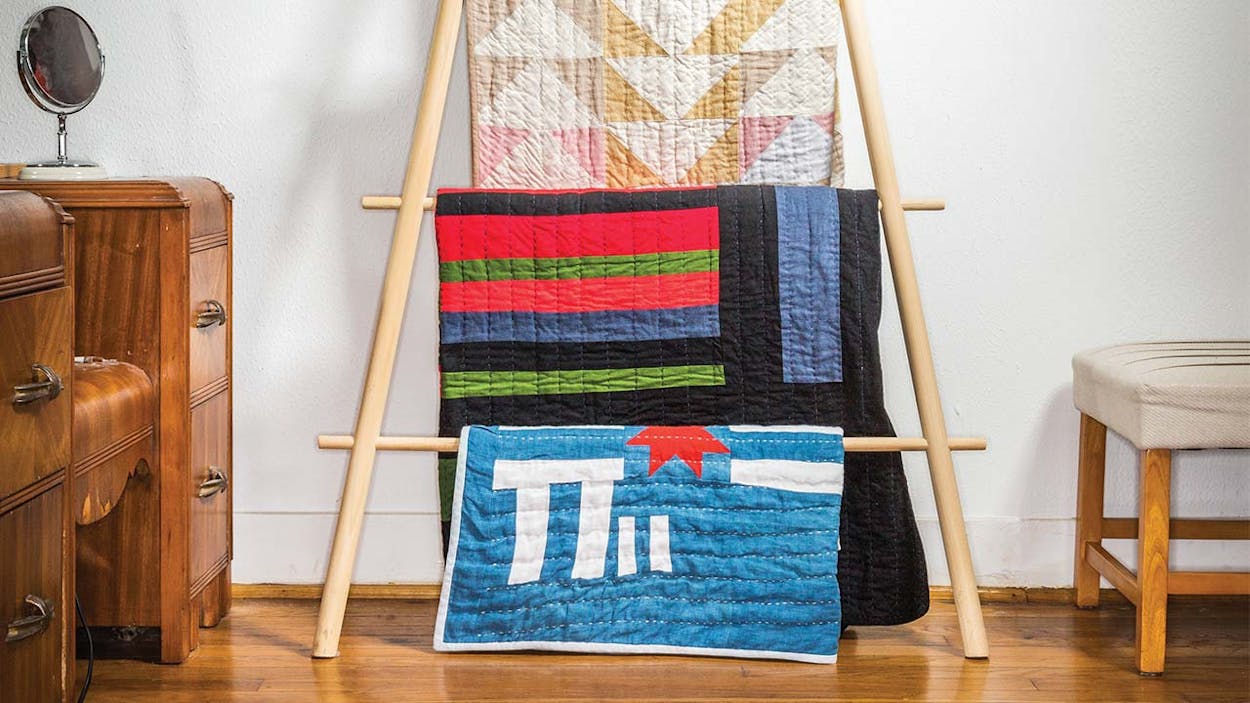Among Ebony Porter’s fondest memories are the camping trips her family would take during her childhood in Australia. In particular, she recalls sitting around the campfire with her mother and grandmother, watching them work on the needlepoint and quilting projects they had brought along. Today Porter (who relocated to Houston with her parents in 1991) continues that tradition of quilting in the wild—which also inspired the name of her business, Campfire Quilts—on travels with her husband and two young daughters. “I’ve quilted along the Icefields Parkway, in Banff, and while watching the sunset on Bowman Lake, in Glacier National Park, Montana, and I’ve spent plenty of hours quilting on the beautiful coastlines in Texas,” she says. “We are heading out to Big Bend in a few months, so you can bet I’ll be quilting along the Rio Grande soon!” When not quilting en plein air, Porter can be found in her small home studio, sewing for up to eight hours at a time, surrounded by plants, artwork, and rocks and shells scavenged while hiking and camping.
Porter’s first sewing projects, as a six-year-old, were making clothes and sleeping bags for her dolls. After high school, she worked for a seamstress, learning her way around industrial sewing machines. Soon, however, her focus shifted to fine art; she studied art history at Texas State University, in San Marcos, and dedicated herself to painting and collage-making. Then, three years ago, her older daughter’s preschool needed a volunteer to sew a quilt for charity. Porter accepted the task, and she hasn’t stopped quilting since. “Quilts have become the centerpiece of my family’s daily life and vacations, so they’re in turn becoming a part of our memories,” Porter says. “I want to give that to other folks too—putting a product in their hands that will become a family heirloom.”

Q&A With Ebony Porter
Do you sew on a machine or by hand?
I piece the quilt top—the decorative patchwork side—by machine, but I do my quilting by hand. The definition of “quilting” is bringing the three layers of a quilt—the top, the batting, and the back—together. Most quilts you see these days are quilted by machine. If I did the quilting process by machine, I could whip out a quilt in a few days easily. But the process of quilting by hand is what takes weeks or months to complete.
Why is it important to you to quilt by hand?
For one, it ensures the durability of the quilt; the hand-stitching will hold strong for decades to come. And I think that in a world where most of our products are machine-made, there is something romantic about building a product that comes to fruition slowly. My love and devotion to this old craft is seen in those imperfect human stitches, which also play a huge part in the aesthetic look of the quilt.
Do you approach making a quilt in the same way that you do one of your paintings?
With a quilt, I tend to hang it on my wall during its varying stages so I can see the development, sort of like a painter standing back from her easel to see how things are progressing. Hanging it to admire like a work of art allows me to decide how the quilt lines are going to look.
There seems to be a debate about whether quilting is an art or a craft. What is your stance on that?
I see it as both. The materials and design alone is art in and of itself. But the process, by virtue of history and tradition, is a craft. Why separate the two? That’s part of the beauty of it all. The quilts do look gorgeous hanging on a wall, but they sure come alive on a bed.
How do you hope people will use your quilts?
I want people to use them and break them in like you would a Persian carpet. The more you use them the better they become! I want to see them indoors and outdoors, used to make forts and for picnics and to keep you warm on a cool night. It’s important to me that these quilts become a part of their owners’ lives through function and purpose.
For more information, go to campfirequilts.com.







